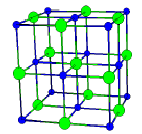Chapter 9: Section 4
Theory of the Thermal Conductivity of Liquids
Leo Peters
CENG 402 Project: April 26, 2002

Even though a
very detailed kinetic theory for the thermal conductivity of monatomic
liquids was developed a half-century ago, means of implementing it
for practical calculations have not been developed. Rough theories
and empirical estimation methods are currently being employed to
provide estimates of the thermal conductivity of monatomic liquids.
Bridgman's theory of energy transport in pure liquids is employed here
in determining thermal conductivities. The following two assumptions
were made:
The molecules are arranged in a cubic lattice, with a
center-to-center spacing given by (Vn/Nn)^(1/3), in which Vn/Nn is the
volume per molecule.
The energy is to be transferred from one lattice plane to the next
at the sonic velocity Vs for the given fluid.
By rearranging the thermal conductivity from the rigid-sphere gas
theory in Equation 9.3-11, the following equation is obtained.
![[Maple Math]](images/project1.gif)
Since the heat capacity at constant volume of a monatomic liquid is
the same as for a solid at high temperature, the Dulong and Petit
formula of Cv = 3(kappa/m) is applied. Better agreement is obtained
for a lower coefficient, so 2.80 is normally used. The mean molecular
speed in the y direction, Uy, is replaced by the sonic velocity Vs.
The distance a that the energy travels between two successive
collisions is taken to be the lattice spacing (Vn/Nn)^(1/3). These
substitutions lead to a modified version of Bridgman's equation
(Equation 9.4-3).
![[Maple Math]](images/project2.gif)
The velocity of low-frequency sound is given by the following equation
(Equation 9.4-4).
![[Maple Math]](images/project3.gif)
Here Cp/Cv can be taken as nearly unity for liquids, except near the
critical point. The remaining quantity can be determined from
isothermal compressibility measurements.
The following link provides an example on how to predict the thermal
conductivity of a liquid.
Example 9.4-1
Here is a list of useful links.
Thermal
Conductivity Conversion Factors
Thermal
Conductivity and Thermal Properties
Thermal
Conductivity of the Elements
Thermal
Conductivity


![]()
![[Maple Math]](images/project2.gif)
![[Maple Math]](images/project3.gif)